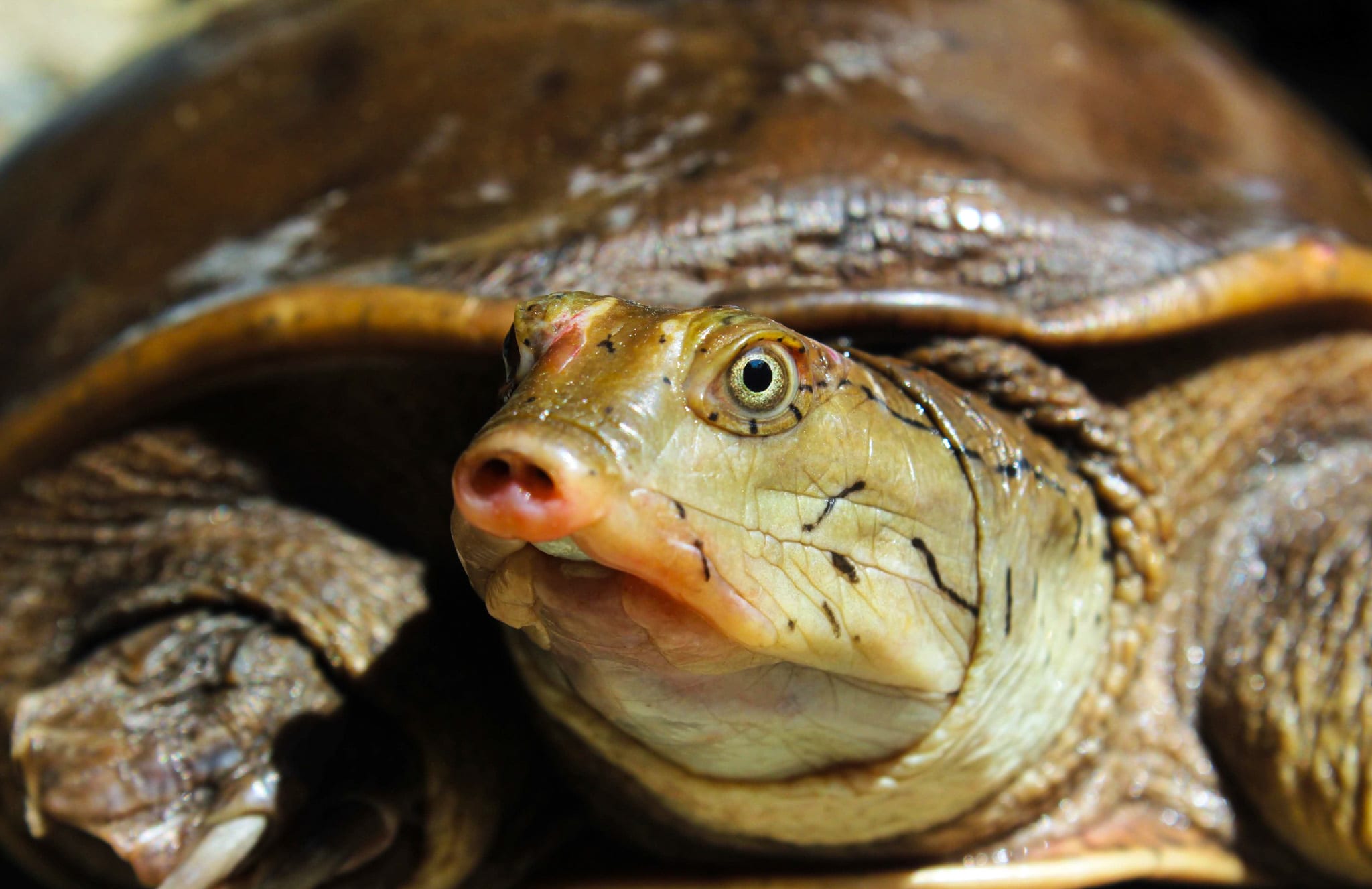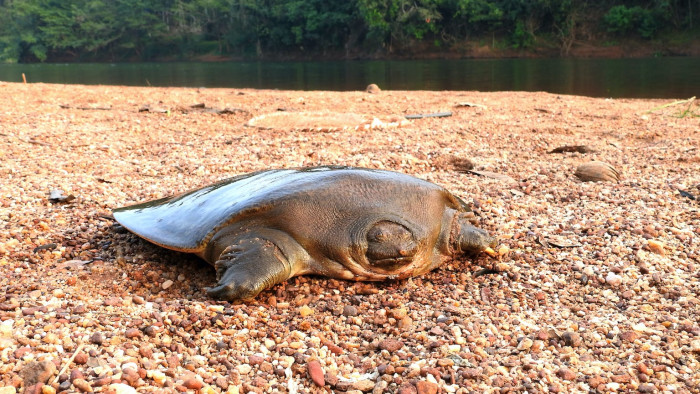A small mud crab crawls along the edge of the murky water of a rain-fed lake near a village in South India. It’s early in the morning and the sun is only beginning to warm the treetops surrounding this idyllic, serene space. The crab begins moving deeper into the water, when suddenly, with barely a ripple, it is grabbed by a vice-like grip cracking its shell and subduing it. The crab became a quick meal for an Indian flapshell turtle (Lyssemys punctata).
The Indian flapshell turtle stays hidden, half buried in the muddy edge of the pond. It waits patiently, without moving, for unsuspecting, fish, frogs, crustaceans or even small birds, reptiles, or rodents to get within striking distance before it snatches them into its jaws. Sometimes, when one turtle grabs hold of something that is a bit too big for it (such as a dove or similar-sized bird), other turtles gather around trying to get a piece of the pie, and jointly partake of the banquet. However, ambush isn’t the only way this very adaptable species gets to eat. It is an opportunistic omnivore. It will readily eat vegetation and dead animals found in or around its pond.

The Indian flapshell turtle’s brown colouration with some spots and relatively small size make it inconspicuous when basking along slow-moving rivers. Photo: Dhritiman Mukherjee
Cover photo: Measuring up to 35 cm, the common flapshell turtle has short, tubular nostrils, which are almost pig-like. Photo: Rahul Kulkarni
Staying buried and unmoving underwater offers great camouflage for this predator. But it also poses the challenge of it not being able to breathe constantly. Flapshell turtles, like all softshell turtles, have very long necks with extended nostrils that look like a pig’s snout. This enables them to stay still, very slowly extend their necks and stick the extreme tips of their nostrils above water for a deep breath before they return to ambush position.
Being reptiles, however, they need to make sure that they are warm enough to digest food and be active. In places where these turtles are not disturbed, they are commonly seen basking on fallen logs, steep edges of ponds, or simply on the banks of the waterbodies that they inhabit. They bask with limbs outstretched, ensuring they dry up completely and soak in as much heat as they need. Yet, they remain ready and able to leap out of their sunbathing stance and dive straight into the water at the slightest disturbance. Like their hard-shelled cousins, the pond terrapins, which are often seen travelling over land from one waterbody to another, flapshell turtles do leave their ponds during the dry season to look for water.
When they need to nest, females climb out of the water, walk above the maximum waterline, getting far enough from the waterbody to ensure their eggs don’t drown if water levels rise. Then they dig a hole in the ground, with their hind legs working like shovels. Once the hole is deep enough, they lay around 12-15 round, white eggs and then cover the hole with the eggs inside a small chamber at the bottom. Here, they will stay for as long as seven months but, usually, around five months. Having completed her maternal duties, the mother returns to the water. The eggs and their growing inhabitants are on their own from then on.
This long incubation period has its share of challenges. Especially in areas with human activity, nests are at constant risk. Agricultural work, various forms of excavation, flooding, and landscape change can destroy the nest in no time at all. Various predators and scavengers may also dig out the nest and feast on the eggs if they catch the scent. Numerous species, from rats to wild boar, are known to eat turtle eggs.
Still, some eggs will hatch, and the little turtles will make their way to the surface. At birth the hatchlings are barely larger than a golf ball. Instinct leads them to the water, where they stay very close to the edge, hiding in aquatic vegetation and the soft bed of the ponds, lakes, or rivers that will be their home for the rest of their lives.
Although tiny, they are like miniature versions of adult turtles. They know how to lie in ambush for prey, burying themselves near the edge of the water so they can stay hidden and simply extend their tiny necks out, their noses just breaking the water’s surface for each breath. Despite all their instinct and inclination to stay away from trouble, these hatchlings face a perilous future.
As hatchlings, they can fall prey to everything from large fish to otters. As they grow, the number of predators reduce. Still, they are fair game for crocodiles, big cats, otters etc. However, the biggest threat to these turtles, individually and as a species, comes from us humans and our activities. Flapshell turtles of all ages get caught in fishing nets, especially, discarded gill nets that are used across the country to fish in lakes, ponds, and rivers. When fisherfolk catch a flapshell turtle in their nets, they usually take it home for the pot. Flapshell turtles are quite the delicacy in many parts of the country. In fact, they are concertedly hunted in some areas. Poachers will wade into ponds and lakes with a sharp spike on the end of a pole and keep jabbing it into the muddy bed below. They collect a lot of crabs and the occasional turtle like this.
Authorities regularly seize and apprehend poachers and illegal traders with consignments of thousands of turtles captured for sale as pets, for their meat, and for use in traditional medicine.
Our laws, although absolute, are not enough to protect our wildlife from greed and exploitation. Understanding the value these animals bring to us is key to their conservation.
The flapshell turtle plays a vital role in freshwater ecosystems. Aside from being effective and voracious predators maintaining the balance of various prey species, they are also cleaners. Adult flapshell turtles will also feed on dead animals found in and near the edge of the water. In fact, many of these turtles were released in the Ganga with the hope that they would feed on the remains of the deceased left in the river. Unfortunately, the levels of pollution in this sacred river don’t allow them to thrive and most of them end up dying or moving away.

Historically, our ancestors understood the role that various animals played in our ecosystem. Flapshell turtles were found in almost every large open well because people knew that they would clear up any small dead animals and keep the water clean. Although this is a terrible thing to do to the individual turtle, it demonstrates an understanding of the value the turtle brings to an ecosystem. Today, if one does see a turtle, it is important to simply leave it alone.
Unfortunately, today we chase profits more than value, and the flapshell turtle is an easy target for exploitation and greed. We need to return to our historic approach and relationship with nature and understand that when these animals thrive, we do too. A good first step would be protecting our wetlands and the wildlife that lives in them not just because they are diverse and integral parts of the ecosystem, but also because protecting them will give us healthier lives and a greater chance of survival.










